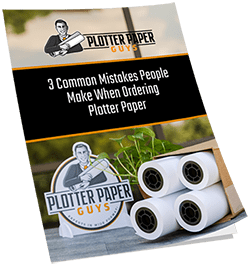Plotter paper is the perfect option for those large-scale projects and designs.
It is typically used by architects, engineers, designers, and those in the construction sector. Unlike printers found in home offices, plotter printers can print using vector graphics that can be scaled to larger sizes without losing the image quality.
This larger-scale paper comes in various sizes, thicknesses, weights, and textures, benefitting many different professions and purposes. This paper is perfect for creating blueprints, technical drawings, or even large-scale displays for advertising.
But what makes plotter printers and the paper different from traditional printers? How many different types and sizes are there?
In this article, we will go over what exactly it is and how serves businesses.
What Is Plotter Paper?
Older plotter printers have pens that create images, unlike traditional printers that make tiny dots to simulate lines. Since some plotter machines have pens that create the pictures, the lines are straighter and continuous. This makes it is ideal for designers, architects, and engineers.
Just like a traditional printer needs a particular type of paper, the same applies to plotter printers. While it typically comes in vellum, vinyl, or bond, the bond paper is more versatile, making it perfect for engineering and architect businesses. It is ideal for many different purposes such as charts or text and has a glossy paper option for advertising or sales pitches.
Types of plotter paper include:
- Bond
- Translucent
- Vellum
- Inkjet
- Xerographic
- Recycled Inkjet
You can use this paper with black ink or even high-resolution color pigment inks. Depending on your needs, make sure you are purchasing the right product depending on if you want to use black or colored ink.
What Is Plotter Paper Used For?
It is most commonly associated with architects and engineers who use computer-aided design software (CAD) to create their images. Advertising agencies and print shops also utilize plotter printers and plotter paper. Since the paper comes in larger than standard sizes, it is the perfect choice for blueprints, designs, and marketing tools.
Architects and engineers most commonly use them for blueprints, but you can also use them to create fine art restoration images. Since plotter paper even comes in glossy options, many advertisement agencies or marketing firms use the rolls to create big pictures and charts for presentations or as displays for the customers.
How Long Should a Plotter Last?
While some have said their plotter machines had lasted 7-10 years, they typically last 3-6 years. While it is more expensive than a traditional printer, they last much longer and print higher quality images.
How long the plotters last also depend on how often you are using them and how well they are maintained. They are meant to last longer and are more durable than traditional printers.
What Are Plotter Paper Sizes?
Rolls typically vary in width sizes, but 36 inches and 42 inches are quite popular. They can go as low as 11 inches wide to the most common, 24 inches. However, it is possible for them to be even wider to accommodate larger projects.
When looking at the sizes on paper rolls, the width number is printed first, then the length number. You will want first to choose the paper size that you will be using most often to maximize the amount of paper for your designs. For example, if you see a 24 roll, this means the paper is 24 inches wide.
Advantages of Plotter Paper
The most significant advantage of plotter paper is that it allows for large-scale designs, unlike traditional printers. Professionals can print their designs either in black ink charts or line drawings or be more advanced and print as multicolor fine art prints using special pigment inks.
Another advantage of this paper and plotter printers is that the designs or charts can be printed many times without sacrificing any details or quality.
Here at Plotter Paper Guys, we offer many different kinds of paper to fit your paper printing needs. We strive to continually evolve our technology and the paper that works best for the current machines.
Disadvantages of Plotter Paper
While the advantages outweigh the disadvantages, there is one disadvantage of plotter machines that are worth mentioning. If you are working with limited space, then the plotter machine and paper might be challenging to set up and use.
Consequently, if you have limited space, the plotter paper roll cartons may be difficult to store. Since they are larger than standard paper sizes, there must be room to keep the paper needed to complete the given task.
Is Plotter Paper the Right Choice for Your Needs?
If you are in a professional field or designer field that requires prints to be on a larger scale, then plotter paper is most likely the right choice for you. This exceptional paper allows for designs, blueprints, or charts to be printed larger without losing any image quality that you would sacrifice if using a traditional printer.
We are dedicated to helping you find suitable materials for your specific printing needs. Contact a professional today if you are unsure of which paper you need, and we will be happy to help.
We offer a vast range of plotter papers that are all high quality and designed to provide the best printing experience. We offer everything from paper for inkjet CAD media designs to paper suited for engineering media. Please browse our website to find the perfect plotter paper to fit your designing needs.




